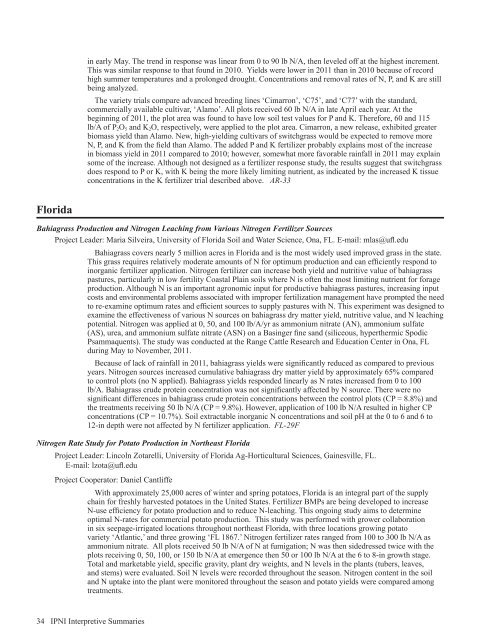Americas and Oceania Group - International Plant Nutrition Institute
Americas and Oceania Group - International Plant Nutrition Institute
Americas and Oceania Group - International Plant Nutrition Institute
You also want an ePaper? Increase the reach of your titles
YUMPU automatically turns print PDFs into web optimized ePapers that Google loves.
in early May. The trend in response was linear from 0 to 90 lb N/A, then leveled off at the highest increment.<br />
This was similar response to that found in 2010. Yields were lower in 2011 than in 2010 because of record<br />
high summer temperatures <strong>and</strong> a prolonged drought. Concentrations <strong>and</strong> removal rates of N, P, <strong>and</strong> K are still<br />
being analyzed.<br />
The variety trials compare advanced breeding lines ‘Cimarron’, ‘C75’, <strong>and</strong> ‘C77’ with the st<strong>and</strong>ard,<br />
commercially available cultivar, ‘Alamo’. All plots received 60 lb N/A in late April each year. At the<br />
beginning of 2011, the plot area was found to have low soil test values for P <strong>and</strong> K. Therefore, 60 <strong>and</strong> 115<br />
lb/A of P 2 O 5 <strong>and</strong> K 2 O, respectively, were applied to the plot area. Cimarron, a new release, exhibited greater<br />
biomass yield than Alamo. New, high-yielding cultivars of switchgrass would be expected to remove more<br />
N, P, <strong>and</strong> K from the field than Alamo. The added P <strong>and</strong> K fertilizer probably explains most of the increase<br />
in biomass yield in 2011 compared to 2010; however, somewhat more favorable rainfall in 2011 may explain<br />
some of the increase. Although not designed as a fertilizer response study, the results suggest that switchgrass<br />
does respond to P or K, with K being the more likely limiting nutrient, as indicated by the increased K tissue<br />
concentrations in the K fertilizer trial described above. AR-33<br />
Florida<br />
Bahiagrass Production <strong>and</strong> Nitrogen Leaching from Various Nitrogen Fertilizer Sources<br />
Project Leader: Maria Silveira, University of Florida Soil <strong>and</strong> Water Science, Ona, FL. E-mail: mlas@ufl.edu<br />
Bahiagrass covers nearly 5 million acres in Florida <strong>and</strong> is the most widely used improved grass in the state.<br />
This grass requires relatively moderate amounts of N for optimum production <strong>and</strong> can efficiently respond to<br />
inorganic fertilizer application. Nitrogen fertilizer can increase both yield <strong>and</strong> nutritive value of bahiagrass<br />
pastures, particularly in low fertility Coastal Plain soils where N is often the most limiting nutrient for forage<br />
production. Although N is an important agronomic input for productive bahiagrass pastures, increasing input<br />
costs <strong>and</strong> environmental problems associated with improper fertilization management have prompted the need<br />
to re-examine optimum rates <strong>and</strong> efficient sources to supply pastures with N. This experiment was designed to<br />
examine the effectiveness of various N sources on bahiagrass dry matter yield, nutritive value, <strong>and</strong> N leaching<br />
potential. Nitrogen was applied at 0, 50, <strong>and</strong> 100 lb/A/yr as ammonium nitrate (AN), ammonium sulfate<br />
(AS), urea, <strong>and</strong> ammonium sulfate nitrate (ASN) on a Basinger fine s<strong>and</strong> (siliceous, hyperthermic Spodic<br />
Psammaquents). The study was conducted at the Range Cattle Research <strong>and</strong> Education Center in Ona, FL<br />
during May to November, 2011.<br />
Because of lack of rainfall in 2011, bahiagrass yields were significantly reduced as compared to previous<br />
years. Nitrogen sources increased cumulative bahiagrass dry matter yield by approximately 65% compared<br />
to control plots (no N applied). Bahiagrass yields responded linearly as N rates increased from 0 to 100<br />
lb/A. Bahiagrass crude protein concentration was not significantly affected by N source. There were no<br />
significant differences in bahiagrass crude protein concentrations between the control plots (CP = 8.8%) <strong>and</strong><br />
the treatments receiving 50 lb N/A (CP = 9.8%). However, application of 100 lb N/A resulted in higher CP<br />
concentrations (CP = 10.7%). Soil extractable inorganic N concentrations <strong>and</strong> soil pH at the 0 to 6 <strong>and</strong> 6 to<br />
12-in depth were not affected by N fertilizer application. FL-29F<br />
Nitrogen Rate Study for Potato Production in Northeast Florida<br />
Project Leader: Lincoln Zotarelli, University of Florida Ag-Horticultural Sciences, Gainesville, FL.<br />
E-mail: lzota@ufl.edu<br />
Project Cooperator: Daniel Cantliffe<br />
With approximately 25,000 acres of winter <strong>and</strong> spring potatoes, Florida is an integral part of the supply<br />
chain for freshly harvested potatoes in the United States. Fertilizer BMPs are being developed to increase<br />
N-use efficiency for potato production <strong>and</strong> to reduce N-leaching. This ongoing study aims to determine<br />
optimal N-rates for commercial potato production. This study was performed with grower collaboration<br />
in six seepage-irrigated locations throughout northeast Florida, with three locations growing potato<br />
variety ‘Atlantic,’ <strong>and</strong> three growing ‘FL 1867.’ Nitrogen fertilizer rates ranged from 100 to 300 lb N/A as<br />
ammonium nitrate. All plots received 50 lb N/A of N at fumigation; N was then sidedressed twice with the<br />
plots receiving 0, 50, 100, or 150 lb N/A at emergence then 50 or 100 lb N/A at the 6 to 8-in growth stage.<br />
Total <strong>and</strong> marketable yield, specific gravity, plant dry weights, <strong>and</strong> N levels in the plants (tubers, leaves,<br />
<strong>and</strong> stems) were evaluated. Soil N levels were recorded throughout the season. Nitrogen content in the soil<br />
<strong>and</strong> N uptake into the plant were monitored throughout the season <strong>and</strong> potato yields were compared among<br />
treatments.<br />
34 IPNI Interpretive Summaries

















